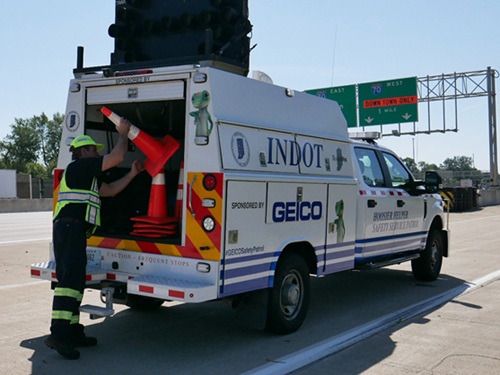Recent research published by the Webber Energy Group (WEG) at the University of Texas at Austin and by The Ray – a nonprofit corporate venture devoted to roadway technology testing – highlights the potential efficiency, economic, societal, and environmental benefits of installing solar arrays on interstate right-of-way or ROW land.
[Above photo via the Federal Highway Administration]
The study revealed that solar panels installed on highway ROWs could generate up to 36 terawatt hours or TWh per year – enough to power 12 million passenger electric vehicles – with the value of the energy generated by roadside solar panels estimated at $4 billion annually.

However, simply installing solar arrays at ROW locales such as interchanges, exits, rest areas, and visitor centers – all of which are maintained by state governments – can be challenging due to safety, environmental, and future land-use considerations, the study emphasized.
To address those challenges, The Ray is collaborating with mapping firm Esri to configure an ROW solar mapping tool that can help users quickly and precisely analyze how suitable and economically valuable ROW locations might be for solar array placement.
The new mapping tool is also capable of producing precise configurations of solar arrays on all types of ROWs, using state department of transportation datasets. Built using Esri’s ArcGIS software suite, the tool includes advanced 3D modeling, solar radiation calculations based on elevation and surface, plus other analysis.

“Since our founding, [we have] been inspired by the opportunity we saw in the underutilized land along highway roadsides,” said Laura Rogers, deputy director of The Ray, in a statement.
“Now, with the support of this cutting-edge solar mapping tool, The Ray can work with transportation agencies across the country to help them envision and plan solar energy projects using their ROW land in a way that simply wasn’t available before,” she noted.
“What used to take weeks or months to evaluate suitability for roadside solar development, this tool that Esri provided accomplishes at a fraction of the time with much more precision,” Rogers added.
In addition to calculating the economic potential of all the land area within ROWs, Esri’s solar tool also enables state DOTs and other transportation agencies to do the following:
- Anticipate unintended consequences and their effect on nearby communities of installing solar panels on the highway roadsides, such as the interruption of scenic views.
- Engage in preliminary site planning exercises, including having the ability to alter the shape, size, or scope of any solar array in order to address a potential social impact, and compare the economics of various scenarios.
- Plan solar arrays on other ROW areas like rest stops and park-and-ride sites, providing solar canopy as well as feeding clean energy into EV charging stations available for commuters.
 Nation
Nation
Confusion Reduces ‘Slow Down, Move Over’ Law Impact
November 14, 2025 Nation
Nation

